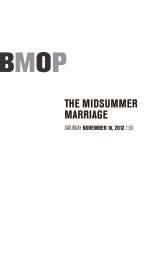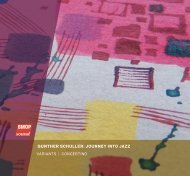Download the album booklet - Boston Modern Orchestra Project
Download the album booklet - Boston Modern Orchestra Project
Download the album booklet - Boston Modern Orchestra Project
Create successful ePaper yourself
Turn your PDF publications into a flip-book with our unique Google optimized e-Paper software.
this wonderful little concerto (<strong>the</strong> shortest of <strong>the</strong> six represented here) might remind<br />
<strong>the</strong> listener of an old story with an updated ending. <strong>the</strong> delightfully puckish clarinet<br />
in this work is ultimately subdued by a passing funeral. this story might be titled, “till<br />
eulenspiegel in new orleans.”<br />
[3] Chamber Concerto III: Ano<strong>the</strong>r View was composed in 1977 and premiered by<br />
<strong>the</strong> saint paul Chamber orchestra with dwight peltzer, piano, and william mcGlaughlin,<br />
conductor. <strong>the</strong> work was revised in 2007 and premiered by <strong>the</strong> boston modern orchestra<br />
project with nina Ferrigno, piano, and Gil rose, conductor. <strong>the</strong> work is scored for solo<br />
piano and chamber orchestra.<br />
<strong>the</strong> salient feature of this concerto comes from a kind of centrifugal technique at <strong>the</strong><br />
core of its composition: <strong>the</strong> work derives all its material from <strong>the</strong> idea of single pitches<br />
being “extended” through repetition, turns, trills, mordents, and so on through much more<br />
complex melodic decoration and extension.<br />
[4] Chamber Concerto IV was composed from 1980–81 and premiered at <strong>the</strong> bowling<br />
Green new music Festival, featuring John sampen, saxophone. <strong>the</strong> work is scored for<br />
solo saxophone and ten players.<br />
as with Chamber Concerto I, this concerto has an important performance ritual that can<br />
only be imagined while listening to <strong>the</strong> Cd. <strong>the</strong> stage is set up with three string players<br />
and three percussionists at far left-rear and far right-rear. <strong>the</strong> two clarinets and two<br />
brass (a trumpet and a trombone) are seated toward center stage rear with empty chairs<br />
reserved for <strong>the</strong> soloist. <strong>the</strong> soloist begins performing on <strong>the</strong> alto saxophone in <strong>the</strong> traditional<br />
position of a soloist beside <strong>the</strong> conductor. about 3½ minutes into <strong>the</strong> piece, <strong>the</strong><br />
soloist walks back, picks up <strong>the</strong> soprano saxophone, and takes a seat with <strong>the</strong> clarinets.<br />
having returned to <strong>the</strong> soloist position again (and playing <strong>the</strong> alto sax) next to <strong>the</strong> con-<br />
ductor, at about 8 minutes <strong>the</strong> soloist walks back to take up <strong>the</strong> soprano sax again, but<br />
this time sits with <strong>the</strong> trumpet and trombone. <strong>the</strong> idea (musically and visually) takes<br />
metaphorical advantage of <strong>the</strong> dual nature of <strong>the</strong> saxophone as both a reed and a brass<br />
instrument.<br />
[5] Chamber Concerto V: Water Music was composed in 1991 and premiered by de<br />
Ijsbreker (amsterdam, <strong>the</strong> ne<strong>the</strong>rlands) with william waterhouse, bassoon. <strong>the</strong> work<br />
was revised from 2006–07 and premiered by <strong>the</strong> boston modern orchestra project with<br />
ronald haroutunian, bassoon, and Gil rose, conductor. <strong>the</strong> original version is scored for<br />
solo bassoon, string quartet, and piano, and <strong>the</strong> revised work is scored for solo bassoon,<br />
flute, percussion, piano, and strings.<br />
beginning in its middle register, <strong>the</strong> bassoon outlines traditional tonal triads and seventh<br />
chords. but <strong>the</strong>se don’t fit toge<strong>the</strong>r as a traditional chord progression. ra<strong>the</strong>r, <strong>the</strong> notes<br />
in <strong>the</strong> first three solo bars combine into <strong>the</strong> complete twelve-note chromatic, creating<br />
an unstable and somewhat atonal atmosphere. building on this subtlety, along with <strong>the</strong><br />
sound of <strong>the</strong> bassoon as it keeps reaching into its upper register, <strong>the</strong> entire concerto has<br />
a primordial feel to it that may remind <strong>the</strong> listener vaguely of <strong>the</strong> opening of stravinsky’s<br />
rite of spring.<br />
[6]–[10] Chamber Concerto VI: Mr. Jefferson was composed in 2007 and premiered<br />
by <strong>the</strong> portland Chamber orchestra with peter sheppard skaerved, violin, and robert<br />
lehmann, conductor. <strong>the</strong> work was revised in 2008 and premiered by <strong>the</strong> boston modern<br />
orchestra project with Charles dimmick, violin, and Gil rose, conductor. <strong>the</strong> work is<br />
scored for solo violin and chamber orchestra.<br />
this concerto is in five interconnected sections, each of which provides a commentary on<br />
one of <strong>the</strong> aspects of <strong>the</strong> personality and accomplishments of thomas Jefferson.<br />
14 15










